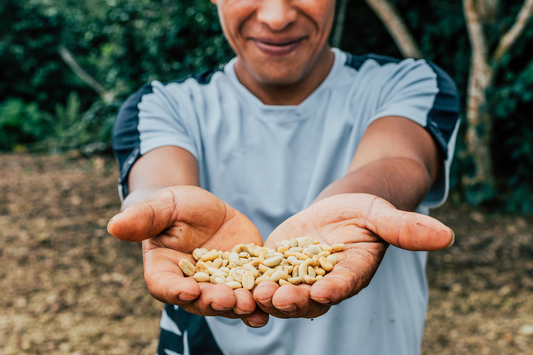
Coffee: An Everyday Luxury, Now Increasingly Out Of Reach?
Share
For most of us, the price of our morning cup of joe isn’t something we’re overly concerned about, though we may subconsciously cut back by getting coffee out less, brewing at home, or buying discounted beans locally. However, moving forward, you might start noticing price increases that demand more attention, as the supply of high-quality arabica coffee becomes scarcer and rising demand drives prices higher.
As of today, January 23, 2025, the coffee commodity market has hit an all-time high, trading at $3.42 USD per pound, up from just $1.81 this time last year. That’s nearly a twofold increase in just 12 months. While this number might not mean much to the average coffee drinker, for roasters, commodity traders, importers, and speculators, it’s top of mind.
So, How Did We Get Here?

A Perfect Storm for Rising Coffee Prices
Weather Volatility Strains Supply
Unpredictable weather patterns have wreaked havoc on coffee production in major exporting countries over the last three years, depleting stockpiles. This year has been especially tough for the two largest coffee exporters:
- Brazil, the world’s largest producer of arabica coffee, endured its worst drought in seven decades, devastating 2024 crop yields.
- Vietnam, the largest producer of Robusta coffee, faced severe weather fluctuations, alternating between extreme drought and heavy rainfall. This is expected to reduce Vietnam's supply by 10%.
Geopolitical Tensions Disrupt Logistics
The ongoing Red Sea conflict has severely impacted the movement of coffee between origin countries and consumer markets. Since October 2023, attacks on ships by the Houthi militia have made this vital shipping route increasingly unsafe.
This route, along with the Suez Canal, is crucial for coffee-exporting nations like Ethiopia and Vietnam, as it allows efficient transportation of beans between Asia and Europe. Without access to this route, companies are forced to take longer, more expensive detours, further delaying shipments, driving up transportation costs, and ultimately increasing the price of coffee.

Robusta Shortages Impact Arabica Supply
While most specialty coffee roasters focus on arabica coffee, the cheaper, less flavourful Robusta species is often used by large companies, like Nestlé, to ease demand pressure on arabica when prices rise.
However, disruptions in Robusta exports due to the Red Sea conflict and Vietnam’s poor harvest have sent prices skyrocketing. As of today, Robusta is trading at $5.22/kg—75% higher than last year. Once a cost-effective alternative, Robusta is now less appealing to roasters, many of which are turning back to Brazilian arabica, which is also experiencing shortage.
Global Sea Container Shortages and Other Disruptions
Adding to these logistical challenges, a global shortage of sea containers has made shipping more difficult. Port congestion, dockworker strikes, and lingering effects of the COVID-19 pandemic—such as increased online shopping—have made it hard to reposition empty containers for new shipments. This scarcity has caused shipping costs to skyrocket as companies compete for the remaining container stock.

Market Speculation, Inflation, and Roasters
The coffee commodity market serves as a pricing and risk-management tool for buying arabica coffee. Speculators analyze factors like weather, geopolitics, macroeconomic trends, and market demand to decide when to buy or sell coffee contracts.
As of January 2025, arabica prices have hit a 50-year high of $3.43 USD per pound. Here are some additional factors contributing to the price surge:
- Short Supply, Excess Demand: Coffee consumption has reached a 20-year high in the U.S., while China, an emerging coffee market, has seen a fourfold increase in consumption since 2010. Traders are betting on limited supply and are driving prices higher.
- Inflation Hedge: Like other commodities, coffee is being used as a hedge against inflation. Investors are buying coffee as a store of value rather than holding onto their nation’s fiat
- Timing the Market: Over the past year, many roasters delayed purchasing coffee, hoping prices would drop. Instead, they were forced to buy at record-high market rates, creating widespread panic. Meanwhile, coffee producers are holding onto their crops in anticipation of even higher prices, with some defaulting on future contracts to capitalize on the market surge.

What This Means for Coffee Drinkers:
Coffee prices are rising, even for affordable options like whole-bean or instant coffee at the grocery store. While coffee may start to feel like a luxury that’s out of reach, there are still ways for coffee lovers to cope:
1. Buy in Bulk: Purchasing larger, fresher quantities can often save money in the long run.
2. Support Local Roasters: We often offer competitive price for fresher and tastier coffee.
3. Keep an eye out for sales: Many roasters and grocery stores frequently put our coffees on promotion, check your email or flyers.
4. Brewing at home remains cheaper than café visits – a small investment in brewing gear can you save you thousands of dollars annually.
For people in the coffee business, like roasters and importers, these challenges mean careful planning, reflection and in some cases redefining their business model moving forward.


